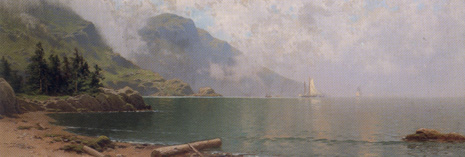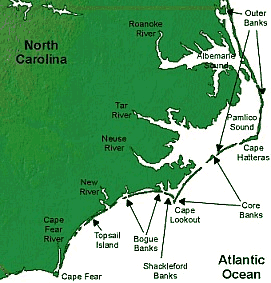

Description of Nature along the Coast
This is an
introductory class that ties geography and ecology to settlement patterns along
North America’s coast using the concept of watersheds. Because it is an
interdisciplinary approach to understanding people and their residential
settings we use natural history, the history of coastal conservation, and
ecological design concepts to allow participants to comprehend coastal biology,
practice urban reforestation, and help in the preservation of marine turtles through
active community engagement. Students will learn about plants and animals
native to the littoral, critique coastal settlement patterns and habitat
preservation plans, and then will actively assist in the creation of a college
arbor on Holt Avenue.
Coastal biogeography and social studies of settlements along the Atlantic and Pacific shores combine in this class to inform you about the geology, biology and economy of the Americas from an historical and ecological perspective.
Our focus is watersheds and the influences of what Darwin called the organic and inorganic features of existence as seen in the places, species and settlements of people along our coasts.
There are three means of determining how we know what lives along the shore, what we have done to the coastal ecosystems and how we may yet coexist with the fragile shoreline where nearly half of the world’s people now live within 100 miles of the ocean or inland seas.
First, we read and you take a test on the coast’s biological communities that we will want to protect. We read about the history of our tidal seas and you write and rewrite an essay about ecological ethics. Third, we will work on an urban ecology project – reforestation and afforestation of a parcel owned by the college to determine how well you can ecologically design a fitting together of land and forest. You present a defense of the design and your ideas in writing at the end of the term. A verbal summary of the approaches and importance of the plan
20% attendance
20% exam & practical – Carson Feb 2d week
20% essay on Coastal Conservation -- Siry Early March (rewritten)
20% essay on plans (Sanibel and Staten Island compared) Early April
20% essay on urban re-forestry project & presentation -- Van der Ryn – late April
100%
You must write, you must
read, and you must rewrite in order to do really well in this course.
College education consists in part of a discourse among the writers of the past with you. Without there ideas, we cannot ably confront the exigencies of the present.
For that reason all writing in
my classes requires a statement as to the explicit sources from which you took
your inspiration, ideas, or quotations. Note the
sources for your writing even if a slight influence by others helped you to
conceptualize your thoughts on the page.
Formal
essays must always have a list of all the authors and titles of the books and periodicals you have read, notes,
and all sources listed with explicit page numbers.
You
are to print all written work, with
numbered pages, and turned in on the date the assignment is due. So, please
plan ahead and start writing one to two weeks before the assignment is due.
Take those drafts to TJs, or to me.
Take
notes on your readings and refer to those in class, discussions of material during class time should
draw from the examples in the assigned readings for that day. Vocabulary
is a significant key to your success in the class. Consult my web page, as
there are several vocabulary entries—from basic terms to obscure
words—on the site.
Failure to do the above, suggested
activities could lead to your failing the course.
Readings for Nature along the Coast and restoring natural
areas
Rachel
Carson, The Edge of the Sea
Joseph
Siry, Marshes of the Ocean Shore
Sim Van der Ryn, Ecological
Design
Selections
(e-reserve, bold password is coast) or Olin Reserve:
Henry Williamson, Tales of Moorland and Estuary
Gary
Kline, The Coastal Envrionment.
Pilkey & Dixon, The Corps and the Shore.
Pilkey,
et. al. Living with the California Coast
John
E. Hoffmeister, Land from the Sea.
Gilbert
Voss, Seashore Life of Florida and the Caribbean
Cutter, Johnson, Finch, & Berry, “The US
Hurricane Coast”
Mangroves
of the tropical Shore (hand out)
Calendar Spring 2008
January
16 What coast are you on? (maps and web site: Siry Course overview)
18 Defining the coasts as Edge of the seas, Williamson, pp. v-19, 131-133.
23 Rachel
Carson and the sea, Gary Kline, pp. 1-31. (handout,
reserve or E-reserve)
24 Global
Warming Teach-In, Crummer Auditorium: 12:30-1:45.
25 What climate chaos does to the shoreline: Cape Sable Fl. And , 100 years ago.
28 Geology of the rising Pacific shore – web search: Mendocino Ecological Staircase
30 tides; their causes and their consequences, Siry web site: tides

February
4 Rocky habitats, Carson. pp. 27-123.
6
tide levels Siry
Web Site and NOAA: http://www.co-ops.nos.noaa.gov/restles1.html
8 visit to Chelonian Institute and Ecological Design ideas
11 Sand beaches: characteristics and critters. Carson, pp. 125-189.
13 Defining patterns of change: vegetation & succession, Siry, pp. 55-58. McHarg reserve.
15 Creatures of the coast, Voss (reserve) & Carson, pp. 248-270.
18 Coral reefs, Carson pp. 190-247, & handout on “Corals, Darwin and cnidaria.” Siry Web
20
Coral, mangroves & grass beds as nurseries for fisheries: Mangroves of the tropic seashores
22 site visit for a college arbor: Ecological Design, Van der Ryn, pp. ix-xi
25 Why restore habitats? reasons by Carson, Siry web and Van der Ryn, pp. 3-32
27 Sanibel Island Plan ( e-reserve )
29 (Leap Year celebration) college arbor site: Bring your own lunch.
March
Complete guide to the Siry book
Overview of landscape renewal.
3 Sand and revegetation: Siry pp. 55-58, 106-109.
5 What is a plan to restore vegetation? McHarg on Web & reserve.
7 Making Beaches turtle safe – outing—(optional beach trip).
10-14 Spring Break – “No classes for you!”
Short guide to the conservation and design parts of course.
17 Estuaries, Siry, pp. 3-17.
19 Rivers and river mouths, Siry, pp. 18-33.
21 bays and sounds, Siry web. And Marshes of the Ocean Shore, pp. 188-191.
24 rivalry, Siry web. & Cutter, Johnson, Finch, & Berry, “The US Hurricane Coast”
26 site visit to college arbor and principles of Ecological Design, web site
28 site plan work on college arbor, Van der Ryn, pp. 33-47.
31 Naturalists and the seashore, Siry, pp. 34-61.
Complete guide to the Siry book
Short guide to the conservation and design parts of course.
April
Overview of Coastal Conservation
2 Character of coastal communities, fisheries. Siry, pp. 35-36, 98-101, 169-174.
4 Site work on college arbor, Van der Ryn, pp. 51-81.
7 Artists and the seashore, Siry web. – You go to Cornell Fine Art Museum before class.
9 Oceanography and commerce, The Corps and the Shore, pp. xi-53. (e-reserve)
11 site plan for college arbor as Ecological Design (E. D.), Van der Ryn, pp. 82-102.
14 Staten Island Plan and Olmsted, E-Reserve (Ian McHarg)
16 Commerce and the Public Trust, Siry, pp. 62-82.
18 site plan work on college arbor , Van der Ryn, pp. 103-159.
21 Ecology and Oceanography, Siry, pp. 83-111.
23 Marine biology and the shore, Siry, pp. 112-133.
25 Shaler & planning areas with principles of Eco. Design. Siry, 105-108. Van Ryn, 160-172.
28 Clements, Tansely, & Leopold: what is plant (dune) succession? Siry, pp. 134-136.
30 Presenting (post) your Ecological Design plans for the college arbor, Van der Ryn, all.
Complete guide to the Siry book
May 5 is the Final Exam, Monday, 2-4 PM in classroom. You present a rehearsed five-minute presentation about what you have learned about protecting coastal wildlife and habitat.
Final
Exams are comprehensive, which means
you must refer to all the readings that were assigned so that I can judge how
familiar you are with their content. The essay's abstract or summary is presented (not read) in a rehearsed
five-minute verbal presentation during the final exam period, including every
author's opinions on preserving natural features along the coasts. Consult
the California Coastal Conservation Plan for a comprehensive, statewide
approach to protecting natural areas.
All written work is formal, in that references with page numbers and
citations based on a bibliography must be clear and consistent. You must
attribute ideas and not just quotations to their respective authors. Few of us
are original thinkers, so cite your influences in all written work as a matter
of scholarly habit.
You
are to print all written work, with
numbered pages, and turned in on the date the assignment is due. So, please
plan ahead and start writing one to two weeks before the assignment is due.
Since all writing is redrafting, I encourage you to write drafts and discuss
them with me well before the due date. Any and all collaborative work must
be proposed in writing and pre-approved by me.
My Intentions
in this course are for you to: Read all the books carefully, take notes and think critically so you
may synthesize several authors around themes in order to express your ideas
more clearly in a variety of writing formats. Take notes on your readings
and refer to those in class. Discussions of material during class time should
draw from the examples in the assigned readings for that day. Vocabulary is a
significant key to your success in the class. Consult my web page, as there are
several vocabulary entries—from basic terms to obscure words—on
that site.
Practice your
writing so that you critically
think and reflect on all of the texts' contents. Write down our discussion’s
focus during class and integrate concepts by informal writing. Bring those
notes to meetings with me. Writing formally requires you to rewrite your
papers.
Write frequently in a variety of forms such as notes,
e-mail, free writing, letters or essays to convey complex ideas in a simple,
clear and direct fashion. Use the Internet to communicate with others.
Rewrite formal papers for class, by using the
writing center at different stages in the composition process from invention
and development to early draft and final production of essays, papers, talks,
or summaries.
Verbally present aloud to the class your questions
drawn from notes on the texts, at least, every two weeks and to practice
informal writing every week from the perspective of oral interpretation of
crucial sections of the texts explaining vocabulary or significant concepts
about which you have questions.
Grades: in
order to receive an:
Average
grade in the course you
must complete and comprehend the contrasts in each of
the above author's perspectives in response papers short essays & a
comprehensive final
paper. An oral presentation based on the paper and the above texts is the final
exam.
C is 70 to 79 percent.
Above
average grade, students
will tie the lectures & discussions to the texts in writing.
B is 80 to 89 percent
Excellent score, exceptional students will participate in text-based discussions and do additional research from the reserve readings and independent inquiry.
Late
assignments are severely
penalized, but going to TJs, the writing center, & Olin Library is
rewarded.
It is my desire for you to excel in this class. To improve your verbal presentations I am asking you to have an interview with me, so schedule an appointment in my office in January. You excel in that interview and the class by reading carefully and asking serious questions about the texts, the evidence they present and the conclusions drawn about how ecological systems are made up of living and non-living functional parts that cooperate in providing food, shelter, nurseries, and resource gathering (ranges) areas for both terrestrial and marine plants, Monera, Protoctista, fungi, plants and animals.